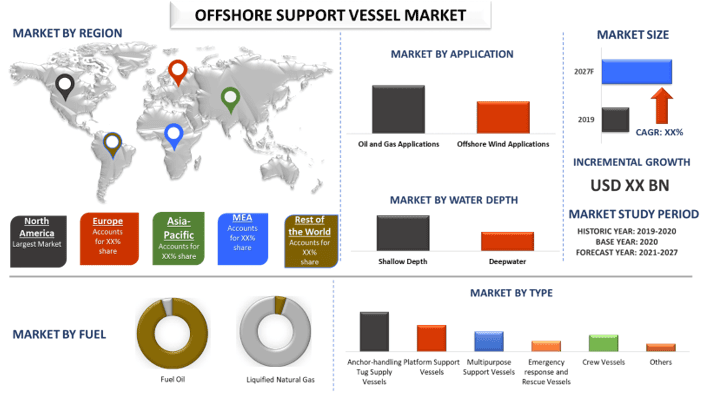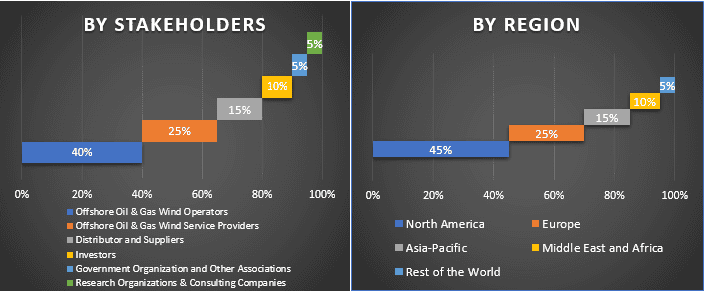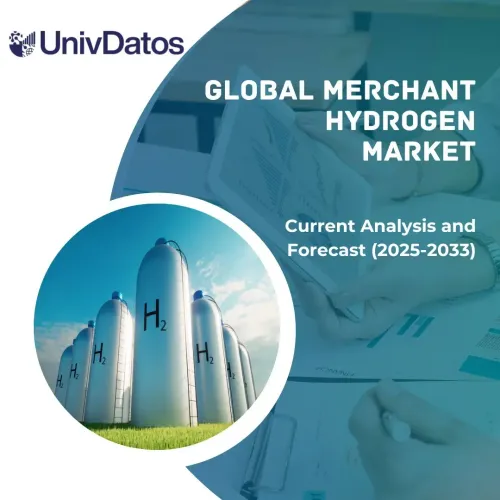- Home
- About Us
- Industry
- Services
- Reading
- Contact Us
Offshore Vessel Market: Current Analysis and Forecast (2021-2027)
Emphasis on Type (Anchor-Handling Tug Supply Vessels, Platform Support Vessels, Multipurpose Support Vessels, Emergency Response and Rescue Vessels, Crew Vessels, Seismic Vessels, Others); Application (Oil and Gas Applications, Offshore Wind Applications); Water Depth (Shallow Water, Deepwater), Fuel (Fuel Oil, Liquified Natural Gas (LNG)); and Region/Country

Global offshore support vessel market is expected to reach the market valuation of approximately US$ 27 billion by 2027 expanding at a reasonable CAGR of above 4% during the forecast period (2021-2027). Offshore power is an important part of the world’s oil and natural gas supply and could be an increasingly important source of renewable electricity. The resources are enormous, and offshore projects are proving their worth in a changing market and in a political context under various stresses on the world’s oceans. For instance, global offshore gas production in 2016 was 17.5 mboe/d and according to IEA’s New Policy Scenario it is expected to increase to 29.6 mboe/d in 2040. Therefore, with increasing production of oil and gas and with high investments in offshore wind energy would increase to support required by offshore support vessels which would further propel the market. However, fluctuating crude oil prices has forced oil companies to cut spending which eventually led to delays or cancellations of contracts with OSV providers, which has reduced the capacity utilization of these vessels which hampered the market growth.
During the Covid-19 pandemic in the early 2020, majority of the countries and region witnessed a country wide lockdown. This has impacted the overall demand for oil and gas. Therefore, by lockdown demand for oil and gas reduced thereby lessening the production for the same and resulting to reduced offshore support vessel operations.
Insights Presented in the Report
“Amongst Type, anchor-handling tug supply vessel category held prominent market share in 2020.”
Currently, anchor-handling tug supply vessel held prominent market share and is expected to retain its position during the forecast period, as it can do various functions together such as mooring chain of drilling rigs, positioning of site, towing of rigs, emergency response and rescue vessel, and fulfill other supply duties when required. However, anchor handling requires high performance, deck space, winch capacity, and other additional handling equipment.
“Amongst Application, oil and gas applications held considerable market share in 2020.”
Currently, oil and gas applications have significant market share. This mainly due to developed oilfields. In addition, most of the offshore oilfields have matured which resulted in exploration and development activities in ultra-deepwater.
“Amongst Water Depth, Deepwater held significant market share in 2020.”
Based on application, the market is bifurcated into shallow water and deepwater. Currently, deepwater holds lucrative market share owing to maturation of shallow water oilfields. Moreover, wind turbines are also placed in deepwater as it provides suitable environment for energy generation.
“North America represents as the prominent market in the Global Offshore Support Vessel Market.”
For a better understanding of the market adoption, report provide detailed analysis for major region and countries including North America (US, Canada, Rest of North America), Europe (Germany, UK, Russia, France, Spain, Rest of Europe), Asia-Pacific (China, Japan, India, Australia, Rest of APAC), MEA (Iran, Iraq, Saudi Arabia, UAE, Kuwait, Rest of MEA), and Rest of World. North America countries such as Canada, U.S., Mexico have increased their E&P activities in offshore areas in the recent past. As land and shallow water reserves are matured, most oil & gas activities have shifted to deepwater. Deepwater exploration and production activities have increased in country such as Mexico. OSVs’ count is also growing in the region due to an increase in the number of vessel manufacturers in the market. Moreover, presence of major oil & gas service providers like Halliburton Co. and Schlumberger Ltd. are operating in the region, thereby helping the operator companies like British Petroleum Ltd and Royal Dutch Shell by using advance techniques to produce oil and gas in huge amounts.
Reasons to buy this report:
- The study includes market sizing and forecasting analysis validated by authenticated key industry experts
- The report presents a quick review of overall industry performance at one glance
- The report covers in-depth analysis of prominent industry peers with a primary focus on key business financials, product portfolio, expansion strategies, and recent developments
- Detailed examination of drivers, restraints, key trends, and opportunities prevailing in the industry
- The study comprehensively covers the market across different segments
- Deep dive country level analysis of the industry
Customization Options:
The global offshore support vessel market can further be customized as per the requirement or any other market segment. Besides this, UMI understands that you may have your own business needs, hence feel free to connect with us to get a report that completely suits your requirements.
Table of Content
Analyzing the historical market, estimation of the current market, and forecasting the future market of the offshore support vessel were the three major steps undertaken to create and analyze its adoption across the globe. Exhaustive secondary research was conducted to collect the historical market numbers and estimate the current market size. Secondly, to validate these insights, numerous findings and assumptions were taken into consideration. Moreover, exhaustive primary interviews were also conducted, with industry experts across the value chain of the offshore support vessel industry. Post assumption and validation of market numbers through primary interviews, we employed a mix of top-down and bottom-up approach to forecast the complete market size. Thereafter, market breakdown and data triangulation methods were adopted to estimate and analyze the market size of segments and sub-segments the industry pertains to. Detailed methodology is explained below:
Analysis of Historical Market Size
Step 1: In-Depth Study of Secondary Sources:
Detail secondary study was conducted to obtain the historical market size of the Offshore Support vessel Market through company internal sources such as annual report & financial statements, performance presentations, press releases, etc., and external sources including journals, news & articles, government publications, competitor publications, sector reports, third-party database, and other credible publications.
Step 2: Market Segmentation:
After obtaining the historical market size of the offshore support vessel market, we conducted a detailed secondary analysis to gather current market insights and share for different segments & sub-segments for major regions. Major segments included in the report are by type, application, water depth, fuel, and region/location. Further regional and country-level analyses were conducted to evaluate the overall adoption of the offshore support vessel globally.
Step 3: Factor Analysis:
After acquiring the historical market size of different segments and sub-segments, we conducted a detailed factor analysis to estimate the current market size of offshore support vessel. Further, we conducted factor analysis using dependent and independent variables such as growing exploration and development activities for oil and gas in ultra-deepwater and rising installation of offshore wind turbines etc. A thorough analysis was conducted for demand and supply-side scenario considering top partnerships, merger and acquisition, business expansion, and product launches in the offshore support vessel industry.
Current Market Size Estimate & Forecast
Current Market Sizing: Based on actionable insights from the above 3 steps, we arrived at the current market size, key players in the global offshore support vessel market, and market shares of each segment. All the required percentage shares split, and market breakdowns were determined using the above-mentioned secondary approach and were verified through primary interviews.
Estimation & Forecasting: For market estimation and forecast, weights were assigned to different factors including drivers & trends, restraints, and opportunities available for the stakeholders. After analyzing these factors, relevant forecasting techniques i.e., bottom-up approach was applied to arrive at the market forecast to 2027 for different segments and sub-segments across the major regions globally. The research methodology adopted to estimate the market size encompasses:
- The industry’s market size, in terms of value (US$) and the adoption rate of offshore support vessel across the major markets
- All percentage shares, splits, and breakdowns of market segments and sub-segments
- Key players in the offshore support vessel market in terms of services offered. Also, the growth strategies adopted by these players to compete in the fast-growing market.
Market Size and Share Validation
Primary Research: In-depth interviews were conducted with the Key Opinion Leaders (KOLs) including Top Level Executives (CXO/VPs, Sales Head, Marketing Head, Operational Head, and Regional Head, Country Head, etc.) across major regions. Primary research findings were then summarized, and statistical analysis was performed to prove the stated hypothesis. Inputs from primary research were consolidated with secondary findings, hence turning information into actionable insights.
Split of Primary Participants in Different Regions

Data triangulation technique was employed to complete the overall market estimation and to arrive at precise statistical numbers of each segment and sub-segment of the global offshore support vessel market. Data was split into several segments & sub-segments post studying various parameters and trends in the areas of type, application, water depth, fuel, and region/location.
The main objective of the Offshore Support Vessel Market Study
The current & future market trends of global offshore support vessel were pinpointed in the study. Investors can gain strategic insights to base their discretion for investments from the qualitative and quantitative analysis performed in the study. Current and future market trends would determine the overall attractiveness of the market at a country level, providing a platform for the industrial participant to exploit the untapped market to benefit as a first-mover advantage. Other quantitative goals of the studies include:
- Analyze the current and forecast market size of offshore support vessel in terms of value (US$). Also, analyze the current and forecast market size of different segments and sub-segments
- Segments in the study include areas of type, application, water depth, fuel, and region/location.
- Defined analysis of the regulatory framework for the offshore support vessel industry
- Analyze the value chain involved with the presence of various intermediaries, along with analyzing customer and competitor behaviors of the industry
- Analyze the current and forecast market size of the offshore support vessel for the major countries
- Major regions/countries analyzed in the report includes North America (US, Canada, Rest of North America), Europe (Germany, UK, Russia, France, Spain, Rest of Europe), Asia-Pacific (China, Japan, India, Australia, Rest of Asia-Pacific), MEA (Saudi Arabia, Iran, Iraq, Kuwait, UAE, Rest of MEA), and Rest of the World
- Company profiles of the offshore support vessel market players and the growth strategies adopted by them to sustain in the fast-growing market
Deep dive country level analysis of the industry
Related Reports
Customers who bought this item also bought










